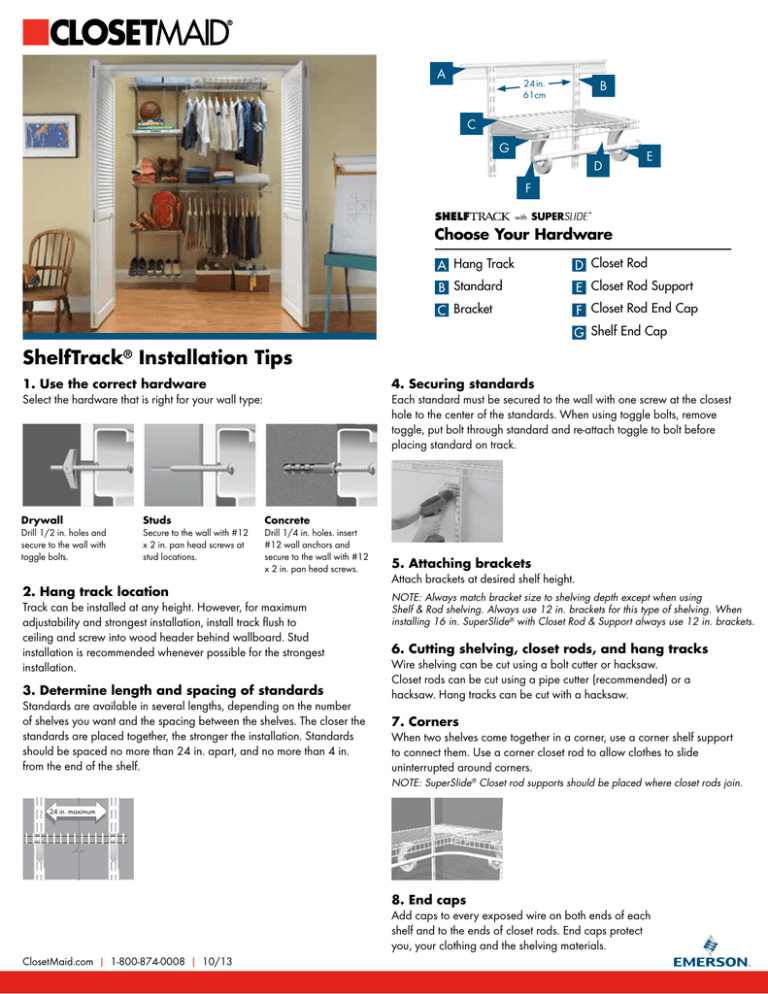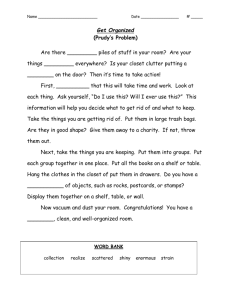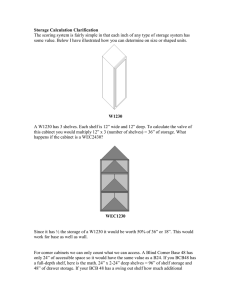ShelfTrack® Installation Tips
advertisement

A 24in. 61cm B C G D E F with Choose Your Hardware A Hang Track D Closet Rod B Standard E Closet Rod Support C Bracket F Closet Rod End Cap G Shelf End Cap ShelfTrack® Installation Tips 1. Use the correct hardware Select the hardware that is right for your wall type: Drywall Drill 1/2 in. holes and secure to the wall with toggle bolts. Studs Secure to the wall with #12 x 2 in. pan head screws at stud locations. 4. Securing standards Each standard must be secured to the wall with one screw at the closest hole to the center of the standards. When using toggle bolts, remove toggle, put bolt through standard and re-attach toggle to bolt before placing standard on track. Concrete Drill 1/4 in. holes. insert #12 wall anchors and secure to the wall with #12 x 2 in. pan head screws. 2. Hang track location Track can be installed at any height. However, for maximum adjustability and strongest installation, install track flush to ceiling and screw into wood header behind wallboard. Stud installation is recommended whenever possible for the strongest installation. 3. Determine length and spacing of standards Standards are available in several lengths, depending on the number of shelves you want and the spacing between the shelves. The closer the standards are placed together, the stronger the installation. Standards should be spaced no more than 24 in. apart, and no more than 4 in. from the end of the shelf. 5. Attaching brackets Attach brackets at desired shelf height. Note: Always match bracket size to shelving depth except when using Shelf & Rod shelving. Always use 12 in. brackets for this type of shelving. When installing 16 in. SuperSlide® with Closet Rod & Support always use 12 in. brackets. 6. Cutting shelving, closet rods, and hang tracks Wire shelving can be cut using a bolt cutter or hacksaw. Closet rods can be cut using a pipe cutter (recommended) or a hacksaw. Hang tracks can be cut with a hacksaw. 7. Corners When two shelves come together in a corner, use a corner shelf support to connect them. Use a corner closet rod to allow clothes to slide uninterrupted around corners. Note: SuperSlide® Closet rod supports should be placed where closet rods join. 24 in. maximum 8. End caps Add caps to every exposed wire on both ends of each shelf and to the ends of closet rods. End caps protect you, your clothing and the shelving materials. ClosetMaid.com | 1-800-874-0008 | 10/13 C B 12 in. 30,5 cm G A D E F Choose Your Hardware A Support Bracket D Closet Rod B Side Wall Bracket E Closet Rod Support C Wall Clip F Closet Rod End Cap G Shelf End Cap Fixed Mount Installation Tips 1. Shelf installation There are three ways to install a shelf: Wall-to-Wall, Wall-to-Open, Open-to-Open. Shelves are supported by wall clips and support brackets or support poles. When a shelf is attached to a side wall, a wall bracket is also used. Choose the right hardware based on the length of the shelf and whether or not it attaches to a side wall. 4. Corners Butt shelves (A). Be sure to allow for the width of the full length shelf when calculating the size of the other shelf. Use a corner support to connect the two shelves. Use a corner hanger bar to connect hanger bars and allow clothes to slide around corners. Or use a corner kit (B) that includes a specially designed corner shelf, corner hanger bar, and all installation hardware. NOTE: Hanger bar supports should be placed where hanger bars join. A. Wall-to-Wall Wall-to-Open B. Open-to-Open 2. Use the right hardware Drywall - Use ClosetMaid hardware with attached anchor in drywall that is 5/8 in. thick or less. Drill 1/4 in. hole, insert hardware, and push in pin using the blunt end of a hammer or screwdriver. Punching the holes in the wall or drilling oversized holes will result in a weakened installation. Hammering pins into the wall can result in broken hardware. 5. Measuring and cutting shelves and hanger bars Wire shelving can be cut using a bolt cutter or hacksaw. Hanger bars can be cut using a pipe cutter. Wood studs - Cut attached anchor off of ClosetMaid hardware and secure to the wall using a #8 x 1 in. screw into the stud. Concrete (all) and plaster or drywall (over 5/8 in. thick) - Drill 1/4 in. hole, insert hardware with attached anchor, and secure to the wall using a #8 x 1 in. screw. 3. End caps Add caps to every exposed wire on both ends of each shelf and to the ends of closet rods. End caps protect you, your clothing and the shelving materials. ClosetMaid.com | 1-800-874-0008 | 10/13 6. Using 16 in. shelving 16 in. shelving provides additional storage capacity. It is especially good for storage of linens or boxes and as shoe shelving. Hanger bars can be installed using 16 in. shelving. When using 16 in. shelving to hang clothes, be sure to use 12 in. support brackets as shown so the shelf is supported properly and hangers can slide unobstructed. 7. Alternative hardware Support poles instead of support bracket when stacking two or more shelves.

